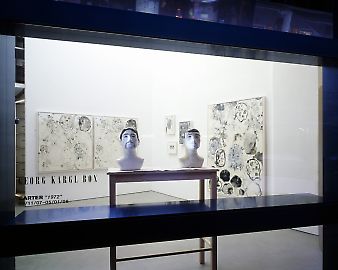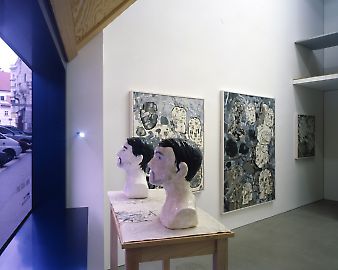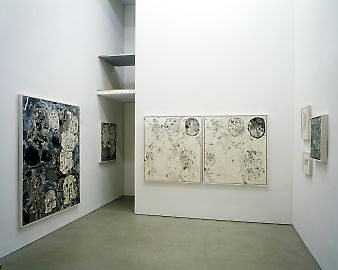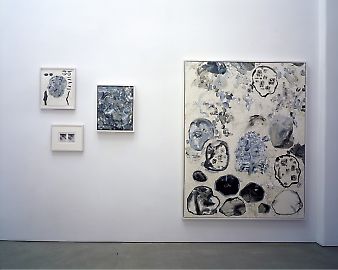Carter -- 1972
The title of his first solo exhibition in Central Europe sounds like a brief biographical marginal note: CARTER “1972.” The New York artist does not want his real first name made public: and the year in quotation marks is neither his date of birth nor the date these works were completed. His play with facts and fictions should not be seen as an attempt to surpass a clear concept of the author and be absorbed in an anonymous artist’s collective striving toward supraindividual practices, a method that has increasingly been attempted in recent years. On the contrary: Carter’s artistic signature appears very characteristic and individual; subtle variations of constantly changing colors, forms, and means of design can be traced throughout his entire oeuvre.
On large format paper or canvas collages, outlines of human body fragments and physiognomic characteristics like heads, eyes, ears, or hands, are contrasted with geometric patterns that are reminiscent of abstracted landscapes. Handmade, marbleized paper is used on the one hand as an abstract background, on the other hand for the visualization of hair. They give the floating heads individual hairdos, a kind of mask, behind which eyes seem to glimpse, or are hidden entirely. Hair, often-synthetic hair directly placed on the canvas, appears beside body parts as artificial elements of human identity constructions. In the fragmentation, the contrast or combination of dehumanized forms, Carter points to the constant transformation of psychological identity and its dependence on social, cultural, or political relationships. Identity is not a clear construct, but is always multilayered and forms in a field of tension between demarcation and adaptation, individuality and uniformity, anonymity and publicness.
The human being stands at the center of Carter’s entire artistic oeuvre — in terms of essential characteristics as well as the formation of an individual personality as a process of a subjective interior view and s construction of external definition and attribution. Not a pure power of imagination is the starting point of his visualization, but intensive body studies of mannequins, sculpture, or photography. Themselves products of an artificial process of transformation and never reality, in his method Carter not only exposes the illusionistic and representational character of painting, sculpture, and photography, but also points out that everything that has to do with gender, sexual or social identity, is not natural, but merely a phenomenon and product of a social and cultural process of construction.
His uniform, life-sized male busts of clay and plaster, marginally individualized by hair, beards, and eyebrows of synthetic hair, seemed to stare ahead through their differently colored glass eyes at a future of clones that has long no longer been utopian. Often, Carter arranges his uncanny sculptures in groups, and indicates with titles like Likeness (Bust #10 and #13) that they can construct the experience of uniqueness, the construction of the self only in distinction and in comparison with the “we,” the experience of part of the whole. Titles like 1949, Self-Portrait as a Homosexual 1965, 1970, can also be read as a open declaration of sexual orientation, while at the same time alluding to a point in art history when gender studies and queer politics found their way into critical discourse.
With his various wigs, costumes, and eccentric manner, Andy Warhol stylized himself into an icon of the queer community, whose theories assume that in the individual self-definition lies to only valid “declaration of identity.” In his critical questioning of identity construction, role-playing, physicality and sexuality as well as in the deconstructive method of asking for the excluded and expanding himself by including the other, Warhol was pioneering for a whole generation.
Carter’s Polaroid series can be interpreted as an open allusion to Warhol, who was one of the first artists to experiment with the instant camera and use it as an artistic medium. In the sense of Pop Art, Warhol used techniques like photo booths and Polaroids to stage himself, famous personalities, or drag queens. If at the time, the fascination of the easily available means of production was central, so easy to use, which in its transformation of the everyday into the artistic also provoked critical questions on commodity fetishism, in the age of digital image generation and reproduction the original aspect of the instant photograph is what fascinates us, the way the Polaroid refuses standard photographic reproduction and reveals sensual qualities in its special color and texture. If Carter places his limbs against plastic backdrops, and in this way photographs himself only while engaging in everyday activities, like drawing, painting, or gluing, he points to the fragmentary construction of reality and its representation. Neither does photography a provide a “true” image of reality, nor is the human body to be understood as a purely natural sphere, but plastic surgery and exaggerated notions of beauty have contributed to perverting the approach to one’s own body towards the artificial.
Text: Fiona Lieweh
An extensive catalogue is being published to accompany the exhibition with an interview with Matthew Higgs and an essay by Fiona Liewehr by Verlag der Buchhandlung Walther König.







